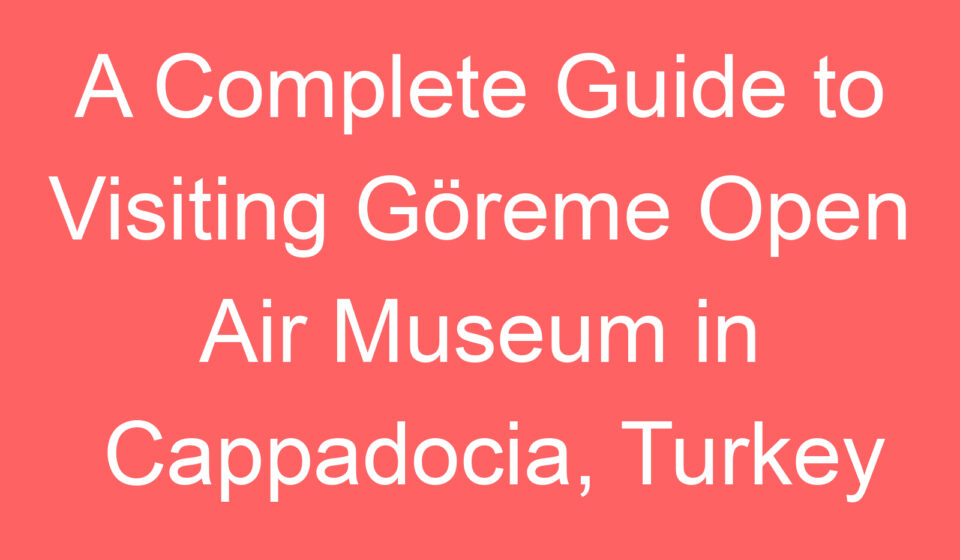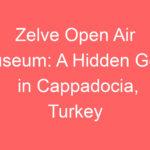
A Complete Guide to Visiting Göreme Open Air Museum in Cappadocia, Turkey
Nestled in the heart of Turkey’s stunning Cappadocia region, the Göreme Open Air Museum stands as one of the country’s most iconic landmarks. Famous for its ancient rock-cut churches, awe-inspiring frescoes, and rich historical significance, this UNESCO World Heritage site offers visitors a journey through time. Whether you are a history enthusiast, art lover, or nature seeker, a visit to this fascinating museum is a must during your time in Cappadocia.
Table Of Content
- Visitor Information
- Location and Getting There 📍🚶♂️
- Opening Hours 🕓
- Ticket Prices 🎟️
- Parking and Facilities 🚗🛍️
- Exhibitions and Collections
- Key Churches to Visit ⛪🎨
- History and Significance 📜✨
- Events and Workshops 🎤🎨
- Practical Tips for Visitors 👟💧
- Visitor Reviews and Insights 💬🌟
- Conclusion 🏰🌄
- Related Posts
Here’s everything you need to know to make the most of your visit.
Visitor Information
Location and Getting There 📍🚶♂️
The Göreme Open Air Museum is situated in Göreme Village, just 1.5 kilometers from the town center, making it easily accessible by foot (a short 20–25 minute walk). However, if you’re not staying within walking distance, options such as taxis, minibuses (dolmuş), private transfers, or rental cars are available. The Red Tour, which is a popular route in Cappadocia, includes a stop at the museum, making it a convenient option for tourists exploring the region.
Opening Hours 🕓
- Summer (April to October): 8:00 AM to 7:00 PM (Last entry at 6:00 PM)
- Winter (November to March): 8:00 AM to 5:00 PM (Last entry at 4:00 PM)
Ticket Prices 🎟️
- Standard Entry: 300 TL (approximately $11 USD) per person
- Students: 50% off with valid student ID
- Children under 8: Free entry
- Additional Charge: The Dark Church (Karanlık Kilise) entry requires an extra fee of 5 TL
Parking and Facilities 🚗🛍️
If you’re driving, paid parking is available about 50 meters downhill from the museum entrance. Be mindful that parking can fill up quickly during peak hours. The museum offers essential facilities, including ATMs, snack bars, drink vendors, and souvenir shops near the entrance.
Exhibitions and Collections
The museum is home to over 30 churches and chapels carved into the soft volcanic tuff rock, many dating back to the 10th–12th centuries. These churches are adorned with stunning frescoes that depict biblical scenes, saints, and geometric patterns. The art and architecture reflect the rich cultural and religious history of the region.
Key Churches to Visit ⛪🎨
- Tokalı (Buckle) Church: The largest and one of the most richly painted, offering vibrant frescoes and a fascinating history.
- Elmali (Apple) Church: Known for its striking dome and simplicity, this church’s frescoes are a must-see.
- Karanlık (Dark) Church: Famous for its exceptionally well-preserved frescoes, this church’s dark interior helped protect the artwork from sunlight damage.
- St. Barbara Church: Unique for its geometric patterns, making it a standout among the other churches.
In addition to the churches, the museum features monastic complexes—living quarters, refectories, and other communal spaces where monks once lived and worked.
History and Significance 📜✨
The Göreme Open Air Museum has a long history, with its origins tracing back to the 4th century. It began as a refuge for early Christians escaping Roman persecution, and later, it became a significant religious hub. By the Byzantine period, the region became an important center for Christian education and religious life, heavily influenced by figures like St. Basil the Great.
In 1984, the museum officially opened to the public, and in 1985, it was inscribed as a UNESCO World Heritage Site. Its rich frescoes, historical significance, and unique geological features make it one of the most important cultural sites in Turkey.
Events and Workshops 🎤🎨
Occasionally, the museum offers workshops that delve deeper into the rich history and artistry of the site. These may include:
- Fresco interpretation sessions, where you can learn about the symbolism and techniques used by Byzantine monks.
- Photography workshops, capturing the incredible views and intricate artwork.
- Christian history workshops, to provide a more profound understanding of the region’s role in early Christianity.
Guided walking tours of the museum and the surrounding area are available in several languages. These tours offer valuable insights into the history and cultural significance of the museum and its frescoes.
Practical Tips for Visitors 👟💧
- Wear Comfortable Shoes: The terrain at the museum can be uneven, with plenty of stairs to climb, so sturdy footwear is a must.
- Visit Early or During Off-Peak Times: To avoid the crowds, it’s best to visit early in the morning or during the shoulder seasons (spring or autumn).
- Plan for Extra Time: With so much history and art to explore, plan to spend at least a few hours wandering through the churches and taking in the incredible frescoes.
- Bring Water and Snacks: While there are facilities nearby, the museum itself can get quite hot, especially in the summer, so staying hydrated is key.
Visitor Reviews and Insights 💬🌟
Tourists consistently praise the “magical setting” of the museum and its surrounding landscape. The combination of rock formations and ancient structures makes for a truly breathtaking experience. Visitors also rave about the frescoes, noting their vividness and historical significance.
Many travelers also comment on the peaceful atmosphere, which provides a stark contrast to the bustling tourist spots of nearby towns. Visitors are advised to bring comfortable shoes, as some of the uphill walks can be challenging, especially in the summer heat. However, the experience is overwhelmingly regarded as worth it.
Conclusion 🏰🌄
A visit to the Göreme Open Air Museum offers a fascinating glimpse into Turkey’s early Christian history, Byzantine art, and the natural beauty of Cappadocia. Whether you’re an art enthusiast, history buff, or simply seeking a peaceful escape in a stunning landscape, the museum offers something for everyone.
Don’t miss out on this incredible cultural treasure on your next trip to Cappadocia!

